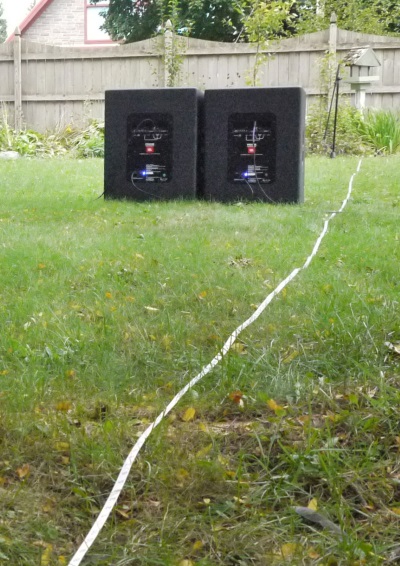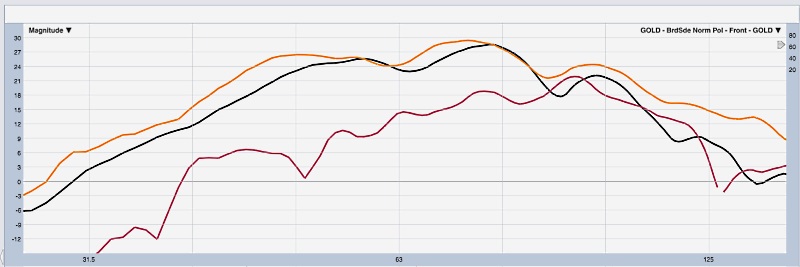
Stacked Gradient Array
Our final stop on this tour involves stacking the two subwoofers on top of each other, with one of the boxes physically reversed. As we’ve discovered, pointing a box the other way does nothing to steer the output, but it’s done here to obtain physical displacement between the drivers – useful if we’re flying a column of them, for example.
The idea is the same as the previous array: the rear-facing box is delayed and then polarity-inverted to cancel the rear-going radiation from the front-facing box. Although the boxes themselves are only about 24 inches deep, the length of the wraparound paths actually approaches that of the inline array, so the timings are similar, and the mechanism still works. Here’s the rub: the rear-facing box has a level advantage at higher frequencies, because they’re no longer omnidirectional, so the level offset between the two boxes increases with frequency (Figure 8).

Notice that in the low end of the range, the levels are matched, but by 100 Hz, the rear sub (black) has a clear lead. Some manufacturers recommend a level offset as an attempt at fixing this, but there are two problems: 1) the level offset between the boxes varies over frequency, so gain won’t fix it, and 2) level offsets (or different EQs) mean that one box will go into limiting before the other, leading to “pattern implosion” when the array is working hard and we need the pattern control the most.
For this reason, the rear cancellation achieved by this array is most effective in the LF range where the levels are matched in the rear, shown with the Gold Standard in Figure 9. In the wild, this array type is commonly seen with at least three boxes, alternating front-back-front.

Wrapping Up
There are other facets of this concept that we don’t have space to delve into here, but I will note that these configurations all need space: since they depend on the wraparound paths to function, they don’t work well when jammed under a stage or against a proscenium.
The question is often raised as to which of these arrays is “best.” The answer depends on the specifics of the situation. Sometimes rear rejection isn’t necessary or even desired. Sometimes it’s paramount. The best outcome is realized by having multiple array types in your “bag of tricks,” understanding the benefits and drawbacks of each, and choosing the most appropriate for each situation.
For more in-depth information, a good starting point is Electro-Voice (electrovoice.com) white paper “Subwoofer Arrays: A Practical Guide” by Jeff Berryman, also available on ProSoundWeb.
